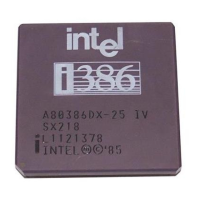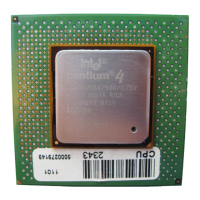96
Intel
®
855GME Chipset and Intel
®
6300ESB ICH Embedded Platform Design Guide
The eight 10 µF, 0805 capacitors (see Figure 45) that are located between the SP capacitors and the
Intel Pentium M/Celeron M processor V
CC-CORE
‘north corridor’ pins also have a pair of
V
CC-CORE
and GND stitching vias on both sides of their terminals. The negative terminals share
V
CC-CORE
and GND stitching via connections with the six 0805 ceramic and SP capacitors
mentioned previously. The positive terminal V
CC-CORE
and GND stitching connections are shared
with the ‘north corridor’ and ground pins of the AF signal row of the Intel Pentium M/Celeron M
processor socket.
To allow good current flow from the SP capacitors to the north side of the V
CC-CORE
corridor pins,
it is recommended that these eight 10 µF 0805 capacitors be spaced 100 mils apart from each other
even if the motherboard design rules allow tighter spacing. The 100 mil horizontal spacing allows
some V
CC-CORE
flood between the capacitor ground pads (see Figure 45) as well as additional
connections to internal Layers 3, 5, and 6 as illustrated in Figure 46. An additional nine 10 µF,
0805 capacitors are placed along the Y signal row of the Intel Pentium M/Celeron M processor
pins on the secondary side below the V
CC-CORE
‘north corridor’ pins under the shadow of the
socket cavity. These nine capacitors are spaced 90 mils apart. Each of these nine 0805 capacitors
have a pair of V
CC-CORE
and GND stitching vias next to both their positive and negative terminals.
The stitching vias connect to the internal ground and V
CC-CORE
planes respectively. The positive
terminal V
CC-CORE
and GND stitching vias are shared with the AA signal row of the Intel Pentium
M/Celeron M processor’s V
CC-CORE
and ground pins.
A wide V
CC-CORE
power delivery corridor flood on the secondary side of the motherboard
connects the 0805 ceramic and SP capacitors that are placed to the north of the Intel Pentium
M/Celeron M processor socket and the nine capacitors that are placed under the shadow of the
socket cavity on the secondary side. The flood is as wide as the whole AF signal row and shall
connect to all the V
CC-CORE
pins in signal rows Y, W, V, and U as illustrated in Figure 45.
The remaining nine (out of 32) 10 µF, 0805 (see Figure 44) capacitors on the secondary side are
used to decouple the remainder of the 24 V
CC-CORE
/GND pin pairs on the south side of the Intel
Pentium M/Celeron M processor socket. These capacitors are placed along signal row G of the
Intel Pentium M/Celeron M processor pins with a 90 mil (or smaller) pitch. Each of the nine
capacitors has a pair of V
CC-CORE
and GND stitching vias on both sides of their terminals. Five out
of nine capacitors share positive terminals with V
CC-CORE
and GND stitching via connections with
signal row F’s V
CC-CORE
and GND pins. The remaining four capacitors are placed next to the
V
CCP
pins of signal row F and have their own V
CC-CORE
vias but do share GND stitching vias.
As shown on the secondary side of Figure 44, a wide V
CC-CORE
flood connects the positive
terminal of these nine capacitors to all 24 V
CC-CORE
pins of the Intel Pentium M/Celeron M
processor pin-map on the south side including the V
CC-CORE
pins of signal rows K, J, H, and G.
The reason for interruption of the V
CC-CORE
flood on the secondary side between the north and
south sides is to allow the V
CCP
corridor connection between the DATA and ADDR sides of the
Intel Pentium M/Celeron M processor socket.
The primary side view in Figure 44 depicts two wide V
CC-CORE
floods that connect from the
V
CC-CORE
stitching vias of the nine capacitors next to their negative terminal to the V
CC-CORE
pins
of the two clusters of the 24 V
CC-CORE
pins in rows K, J, H, G, F, E, and D of the Intel Pentium
M/Celeron M processor pin-map.
Note: The specific arrangement of the vias for the V
CC-CORE
dog bones to allow connection of all
V
CC-CORE
BGA balls in this cluster of 24 pins to the V
CC-CORE
flood shapes on the primary.
As shown in Figure 44, the V
CC-CORE
floods are isolated between the north and south sides of the
V
CC-CORE
pins of the Intel Pentium M/Celeron M processor socket on both the primary and
secondary sides. The reason for the discontinuity of the V
CC-CORE
floods on the primary and
secondary sides is to facilitate V
CCP
power delivery. Consequently, this allows the V
CCP
corridor

